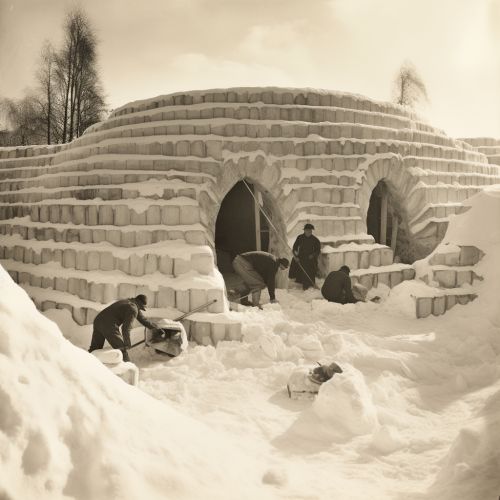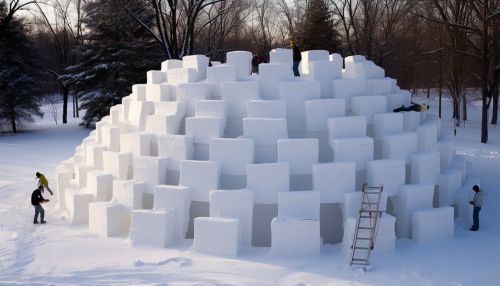Igloo
Introduction
An Igloo is a type of shelter constructed from snow, traditionally used by the Inuit people of the Arctic regions of Greenland, Canada, and Alaska. The term igloo, or iglu, originates from the Inuit language, meaning 'house' or 'building'. These structures are renowned for their unique dome-shaped design and the remarkable insulating properties of the snow from which they are built.
History
The use of igloos dates back several centuries, with the earliest recorded use by the Thule people, the ancestors of the modern Inuit. The Thule migrated from Alaska to Greenland around 1000 AD, bringing with them the knowledge and techniques of igloo construction. The igloo was a vital survival tool in the harsh Arctic environment, providing shelter from the extreme cold and wind.
Construction
The construction of an igloo requires specific techniques and understanding of the properties of snow. The snow used in construction must be of the right consistency - not too soft or too hard. The snow is cut into large blocks using a snow knife, a tool traditionally made from caribou antler or, more recently, metal. These blocks are then carefully arranged in a spiral pattern, gradually leaning inwards to form the distinctive dome shape.


The blocks are shaped and fitted together with precision, ensuring stability and structural integrity. The gaps between the blocks are filled with loose snow to provide additional insulation and to seal the structure from drafts. The final block to be placed is the keystone at the very top of the dome, which locks all the other blocks into place.
Design and Features
The design of an igloo is a marvel of engineering, demonstrating a deep understanding of the principles of physics and thermodynamics. The dome shape of the igloo distributes the load evenly across the structure, making it incredibly strong and able to withstand high winds and heavy snowfall.
The interior of an igloo is surprisingly warm and comfortable, despite being made entirely of snow. This is due to the insulating properties of snow, which traps air in its structure, slowing the transfer of heat. A small hole at the top of the igloo allows for ventilation, preventing the buildup of moisture and condensation.
In addition to the main living area, many igloos feature additional rooms or spaces for storage, cooking, and sleeping. Some larger igloos, known as 'qaggiq', were used for community gatherings and could accommodate up to 20 people.
Cultural Significance
The igloo is more than just a practical survival tool for the Inuit; it is a symbol of their resilience and adaptability. The skills and knowledge required to build an igloo are passed down from generation to generation, forming an important part of Inuit culture and tradition.
Despite the increasing availability of modern housing materials and technologies, many Inuit continue to use igloos for hunting trips and other outdoor activities. The igloo remains a potent symbol of Inuit identity and a testament to their ingenuity and resourcefulness in one of the world's harshest environments.
